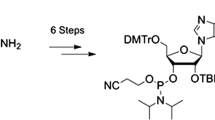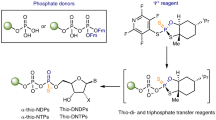Summary
The self-condensation of 2′(3′)-O-glycyl esters of adenosine, adenosine-5′-(O-methylphosphate) and P1, P2-diadenosine-5′-pyrophosphate in 6.2 mM solutions at pH 8.0 and -5°C in the presence of 12.5 mM poly(U) yields approximately 3 times as much diketopiperazine as reactions without poly(U). As the concentration of 2′(3′)-O-(glycyl)-P1, P2-diadenosine-5′-pyrophosphate is decreased from 6.2 mM to 1.5 mM the yield of diketopiperazine in the presence of poly(U) decreases slightly from 6.6% to 5.2%, whereas, in the absence of poly(U) the yield of diketopiperazine decreases substantially from 2.4% to 0.75%. The enhanced yield of diketopiperazine that is attributed to the template action of poly(U) is temperature dependent and is observed only at temperatures below 10°C (5°C to -5°C) for 6.2 mM 2′(3′)-O-(glycyl)-adenosine-5′-(O-methylphosphate) and below 23°C (15°C to -5°C) for 6.2 mM 2′(3′)-O-(glycyl)-P1, P2-diadenosine-5′-pyrophosphate. The absence of a template effect at high temperatures is attributed to the melting of the organized helices. The hydrolysis half-lives at pH 8.0 and -5°C of 2′(3′)-O-(glycyl)-adenosine, 2′(3′)-O-(glycyl)-adenosine-5′-(O-methylphosphate), 2′(3′)-O-(glycyl)-P1, P2-diadenosine-5′-pyrophosphate, and 5′-O-(glycyl)-adenosine in the presence of poly(U) are substantially larger than their half-lives in the absence of poly(U). The condensation of 2′(3′)-O-(glycyl)-adenosine yields 5% of 5′-O-(glycyl)-adenosine in the presence of poly(U) compared to 0.7% in the absence of poly(U).
Similar content being viewed by others
Abbreviations
- DKP:
-
diketopiperazine
- (gly)2 :
-
glycylglycine
- (gly)3 :
-
glycylglycylglycine
- AppA-gly:
-
2′(3′)-O-(glycyl)-P1, P2-diadenosine-5′-pyrophosphate
- MepA-gly:
-
2′(3′)-O-(glycyl)-adenosine-5′-(O-methylphosphate)
- Ado-2′(3′)-gly:
-
2′(3′)-O-(glycyl)-adenosine
- Ado-5′-gly:
-
5′-O-(glycyl)-adenosine
- Boc-gly:
-
N-tert-butyloxycarbonylglycine
- AppA:
-
P1, P2-diadenosine-5′-pyrophosphate
- MepA:
-
adenosine-5′-(O-methylphosphate)
- AppA-Boc-gly:
-
2′(3′)-O-(Boc-glycyl)-P1, P2-diadenosine-5′-pyrophosphate
- Ado-5′-Boc-gly:
-
5′-O-(Boc-glycyl)-adenosine
- Ado-2′(3′)-Boc-gly:
-
2′(3′)-O-(Boc-glycyl)-adenosine
References
Arnott S, Bond PJ (1973) Nature (London) 244: 99–101
Chung NM, Lohrmann R, Orgel LE (1971) Biochim Biophys Acta 228: 536–543
Chung SK, Copsey DB, Scott AI (1978) Bioorg Chem 7: 303–312
Coles N, Bukenberger MW, Meister A (1962) Biochemistry 1: 317–322
Davies RJH, Davidson N (1971) Biopolymers 10: 1455–1479
Goldstein L, Levin Y, Katchalski E (1964) Biochemistry 3: 1913–1919
Hecht SM (1977) Tetrahedron 33: 1671–1696
Hopfield JJ (1978) Proc Natl Acad Sci USA 75: 4334–4338
Ito M, Hagiwara D, Kamiya T (1975) Tetrahedron Lett, 4393–4394
Lohrmann R, Orgel LE (1978) Tetrahedron 34: 853–855
Novogrodsky A (1971) Biochim Biophys Acta 228: 688–692
Pinck M, Schuber F (1971) Biochimie 53: 887–891
Purdie JE, Benoiton, NL (1973) J Chem Soc, Perkin Trans 2: 1845–1852
Schuber F, Pinck M (1974a) Biochimie 56: 383–390
Schuber F, Pinck M (1974b) Biochimie 56: 391–395
Schuber F, Pinck M (1974c) Biochimie 56: 397–403
Strickland JE, Jacobson KB (1972) Biochemistry 11: 2321–2323
Ts'o POP (1974) Bases, nucleosides, and nucleotides. In: Ts'o, POP (ed) Basic principles in nucleic acid chemistry. Academic Press, New York, vol 1, p 453
Walder JA, Walder RY, Heller MJ, Freier SM, Letsinger RL, Klotz IM (1979). Proc Natl Acad Sci USA 76: 51–55
Weber AL, Orgel LE (1978) T Mol Evol 11: 189–198
Weber AL, Orgel LE (1979) T Mol Evol 13: 185–192
Wolfenden R (1963) Biochemistry 2: 1090–1092
Zachau HG, Feldmann H (1965) Amino acid esters of RNA, nucleosides, and related compounds. In: Davidson JN, Cohn WE (eds) Prog Nucleic Acid Res Mol Biol Academic Press, New York, vol 4, p 217
Author information
Authors and Affiliations
Rights and permissions
About this article
Cite this article
Weber, A.L., Orgel, L.E. Poly(U)-directed peptide-bond formation from the 2′(3′)-glycyl esters of adenosine derivatives. J Mol Evol 16, 1–10 (1980). https://doi.org/10.1007/BF01732065
Received:
Revised:
Issue Date:
DOI: https://doi.org/10.1007/BF01732065




